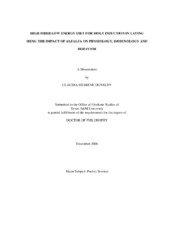| dc.contributor.advisor | Berghman, Luc R. | |
| dc.contributor.advisor | Ricke, Steven C. | |
| dc.creator | Dunkley, Claudia Sharene | |
| dc.date.accessioned | 2010-01-14T23:56:24Z | |
| dc.date.accessioned | 2010-01-16T00:55:30Z | |
| dc.date.available | 2010-01-14T23:56:24Z | |
| dc.date.available | 2010-01-16T00:55:30Z | |
| dc.date.created | 2006-12 | |
| dc.date.issued | 2009-05-15 | |
| dc.identifier.uri | https://hdl.handle.net/1969.1/ETD-TAMU-1186 | |
| dc.description.abstract | Feed withdrawal is commonly used by commercial egg producers to induce molt and stimulate multiple egg-laying cycles in their flocks. However, the practice can compromise the welfare of the birds by elevating stress, suppressing the immune response and causing abnormal behavior. An alternate molt diet was examined using alfalfa diets, and a series of experiments were conducted to evaluate the physiological, immunological and behavioral responses of laying hens fed these diets. We assessed the changes in the levels of blood plasma metabolites after hens were challenged with 106 colony forming units of Salmonella Enteritidis (SE). Hens fed alfalfa diets displayed similar (P ≥ 0.05) levels of cholesterol, glucose, and total protein when compared to full-fed hens. Reduced levels (P ≤ 0.05) of triglycerides were observed in the alfalfa fed and feed withdrawal hens when compared to the full-fed hens. The immune responses of SE challenged laying hens fed alfalfa diets showed similar (P ≥ 0.05) heterophil to lymphocyte ratios (H: L) to full-fed hens whereas the feed withdrawal hens displayed elevated (P ≤ 0.05) H: L ratios. The feed withdrawal hens displayed reduced (P ≤ 0.05) levels of serum IgY early in the trial when compared to the alfalfa and full-fed hens. The alfalfa fed hens displayed lower levels of acid α glycol protein than the feed withdrawal hens and higher levels than the full-fed early during the trial but returned to levels that were similar (P ≥ 0.05) to the full-fed hens. The hens fed alfalfa diets displayed elevated non-nutritive pecking behavior early in the trial however, this behavior declined to levels similar (P ≥ 0.05) to the full-fed hens by the end of the trial. No differences in aggressive behavior were observed between the alfalfa fed hens and the full-fed hens. Hafnium chloride did not effectively mark the alfalfa diet; however, it can be used to track the passage of corn-soy layer ration. This research suggests that the application of alfalfa as an alternative molt diet can be effective in reducing potentially harmful effects which are usually associated with feed withdrawal. | en |
| dc.format.medium | electronic | en |
| dc.format.mimetype | application/pdf | |
| dc.language.iso | en_US | |
| dc.subject | Molting | en |
| dc.subject | Laying hens | en |
| dc.title | High fiber low energy diet for molt induction in laying hens: the impact of alfalfa on physiology, immunology and behavior | en |
| dc.type | Book | en |
| dc.type | Thesis | en |
| thesis.degree.department | Poultry Science | en |
| thesis.degree.discipline | Poultry Science | en |
| thesis.degree.grantor | Texas A&M University | en |
| thesis.degree.name | Doctor of Philosophy | en |
| thesis.degree.level | Doctoral | en |
| dc.contributor.committeeMember | Friend, Ted H. | |
| dc.contributor.committeeMember | Kubena, Leon F. | |
| dc.contributor.committeeMember | McReynolds, Jackson, L. | |
| dc.type.genre | Electronic Dissertation | en |
| dc.type.material | text | en |
| dc.format.digitalOrigin | born digital | en |


